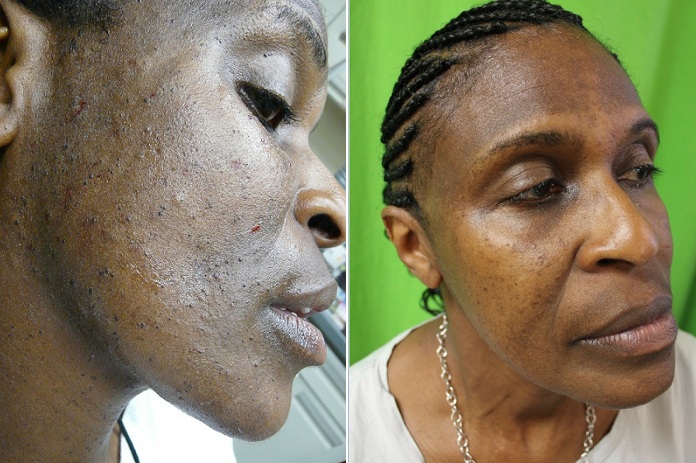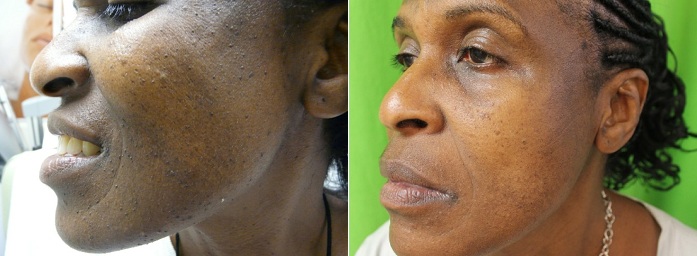Dermatosa Papulosa Nigra is a benign skin condition that looks like brown or black moles on the face, between 1-5mm in diameter. They are flat and slightly raised from the skin’ surface. Sometimes they protrude significantly and look like dark skin tags. Los Angeles Dermatosa Papulosa Nigra patients may want to learn more about the general characteristics of this condition and options for treatment.
DPN bumps often develop in the following areas:
- under the eyes
- cheeks
- forehead
- neck
- chest
- upper back
Because they are harmless, most people who choose to have them removed do so for cosmetic reasons. This often results in a more clear and unform skin complexion.
Who Is Affected?
Dermatosa Papulosa Nigra affects about 35% of the African American population. And it is also seen in Asian patients as well. The condition tends to develop in more women than men.
Causes of Dermatosa Papulosa Nigra
It is not certain what exactly causes Dermatosa Papulosa Nigra. However, nearly half of all afflicted individuals have a family history of the condition.
These lesions may be caused by a developmental abnormality in the psilosebaceous follicle. Bumps usually start to appear around adolescence.
How Dermatosa Papulosa Nigra Is Different From Regular Moles
Dermatosa Papulosa Nigra is not quite the same as the common skin mole since they are related to follicles in the skin.
Moles, on the other hand occur when skin cells known as melanocytes clump together. Melanocytes produce melanin, which is the pigment that colors our skin. They are normally distributed evenly. But occasionally they will group together.
Asymmetrical moles should be noted as a possible malignant growth. However, it is quite common to see DPN lesions where one side is shaped differently from the other.
Dermatosa Papulosa Nigra bumps often increase in number over time. Also, these bumps often grow in size with age.
Severity of DPN Moles
Although they are benign, dermatologists will classify Dermatosa Papulosa Nigra lesions according to severity.
- fewer than 10 papules: mild
- more than 10 papules: moderate
- greater than 50 papules: severe
Los Angeles Dermatosa Papulosa Nigra Procedures
Patients who want to get rid of Dermatosa Papulosa Nigra may want to become familiar with the following types of treatment:
1) Cryosurgery
Liquid nitrogen is used to freeze unwanted tissue
2) Scraping or excision
Surgical tools can be used to scrape the raised tissue from the surface. Or the lesion can be excised by cutting around the perimeter.
The resulting wound needs to be closed with sutures.
3) Electrocautery
In electrocautery, an electric current is used to make necessary cuts to remove the tissue. It is also applied to seal off blood vessels that feed the DPN tissue.
4) Nd:YAG laser
The Nd:YAG laser uses the 1064nm wavelength which is safe for patients of all skin tones. The heat from this energy will seal off blood vessels that cause the DPN tissue to grow. Also it will cause the melanin to coagulate, forming a mass of debris that is broken down and carried away by the body. This natural process of removal results in minimal scarring.
Research has shown that laser procedures using the ND:YAG system is quite effective in the treatment of Dermatosa Papulosa Nigra. Examples include:
- 2008 study published in the Journal of Cosmetic and Laser Therapy
- 2009 study published by the Institute of Laser at the Sudan University of Science and Technology
Laser energy is non invasive. And it is able to make very precise tissue changes with very little risk of complications such as pigmentation or the development of keloids.
Pain Management for Dermatosa Papulosa Nigra Procedures
Topical anesthesia can be used to maximize the patient’s comfort level during their removal procedure. This includes:
1) EMLA which is a combination of topical lidocaine and prilocaine cream
2) LMX which is a topical lidicaine cream
Los Angeles Patient Example of Dermatosa Papulosa Nigra Treatment
This Los Angeles patient wanted to get rid of Dermatosa Papulosa Nigra bumps on her face. She was successfully treated with a light form of electrocautery. Here are before and after pictures of her results.
Free Consultations For Dermatosa Papulosa Nigra
Los Angeles Dermatosa Papulosa Nigra patients may sign up for a complimentary consultation at Fine Touch Dermatology to learn more about relevant treatment options for their case.
Interested individuals can sign up using our online consultation form at the top of the page or call us at 877-337-6424


